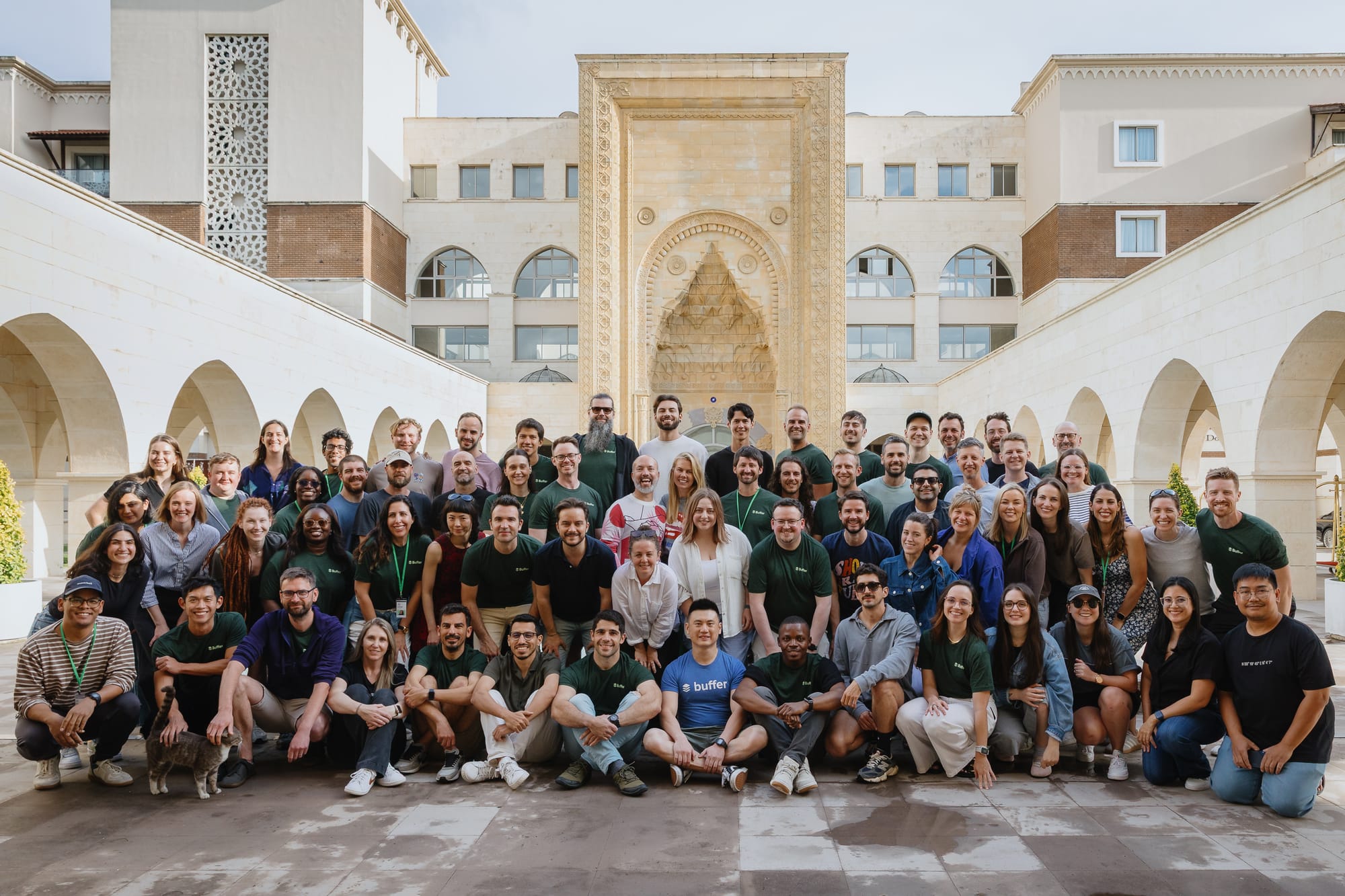
How We Plan Retreats, After Hosting 14 over 12+ Years (+ Get Our Retreat Planning Playbook!)
We've been hosting Retreats at Buffer for 12+ years. In this article, we've detailed everything we've learned from 14 Retreats.

Senior People-Ops Specialist @ Buffer
At Buffer, we're a fully remote and distributed team, which means that for most weeks of the year, we work together across 21 different countries and 49 cities. For one glorious and cherished week a year, we meet together in person for a working week we call “Retreat” to collaborate and connect.
We recently wrapped up Buffer's 14th Retreat in Antalya, Türkiye! The week after we returned home, our planning team met to celebrate and debrief a successful Retreat, and you guessed it, gear up to do it all again for our 2026 Retreat!
Buffer has been hosting annual Retreats for nearly a decade, and while the heart of Retreat hasn’t changed, the logistics definitely have! With teammates flying in from more countries than ever, and new health considerations in the mix post-Covid, our planning has evolved. Our current People team has organized the last two Retreats (in Cancún, Mexico, and Antalya, Türkiye), and we’ve landed on a model that blends years of wisdom with the needs of a modern, distributed team. We’re excited to share what’s worked for us!
Why we host Retreats
When we’re deeply connected as a team, remote work flows so much more easily. That's why during Retreat week, we prioritize productive work, meaningful connection, and plenty of fun during our in-person time. There's truly nothing like spending real-life time with your teammates, especially when it only happens once a year!
Buffer Retreats give space for deep convos over coffee, late-night karaoke, shared meals, spontaneous lobby meet-ups, and all the little moments that remind us why we do this work together (we like to call it Retreat magic ✨).
Because we know just how valuable these moments are, we take great care in crafting a positive and impactful experience for every teammate, at every Retreat. We've learned a lot, and hit a few many bumps along the way, but each one taught us something new and helped shape the playbook we're sharing with you today!
Jump to a section:
10 key steps for planning a Buffer Retreat
These 10 steps are the foundation of our planning process, whether we’re heading to Türkiye or somewhere brand new. We'll walk you through each one below!
1. Set your vision: Define goals, budget, and non-negotiables
Before you dive headfirst into hotel hunting and spreadsheets, hit pause and ask: What kind of Retreat do we actually want? Gather your stakeholders and align with leadership before locking anything in.
This is your chance to zoom out and dream a little. What are your top goals for Retreat? Is it deepening team connection? Time for strategy and planning? Or simply a week of sunshine and snacks with your favorite coworkers? All great options, but aligning on your goals early will shape every decision that follows.
Once you've got some high-level goals, it helps to jot down a few non-negotiables such as meeting spaces to accommodate your full team or close proximity to a major airport, your Retreat ideals or “wishlist” (hello, outdoor dinners and optional morning yoga), a rough sense of the schedule for the week, and of course, budget.
Setting a clear vision up front makes the planning way smoother, and sets you up for a week that is actually productive for your team, not just busy!
Non-negotiables for Buffer Retreats:
- Visa-friendly destination: While we're open to traveling to many great destinations (and have teammates all over the world!), one of our highest priorities is finding a country for which most of our teammates can obtain visas for travel.
- Weather: While we don't need a tropical location, we love having the option to host events outside and so we aren't inside all week. A destination that allows for some outdoor meetings and meals is ideal. (This also helps prevent or slow down the spread of any sicknesses that pop up. We have some experience with Retreat Flu, and have learned our lesson!)
- Close proximity to a major airport: This helps minimize layovers and travel time, which reduces jet lag, and ultimately makes for a more productive week.
- Proper work and/or meeting space: We're onsite working together for the week, so we need adequate space for our full team to work together collectively, and multiple breakout rooms for smaller team or department sessions. All spaces need strong wifi, outlets for charging, projectors, and screens.
- Every teammate has their own bedroom and bathroom: No sharing rooms for us. Everyone needs space for downtime, especially those of us battling jetlag, so we'll rule out properties early on if they can't accommodate our full team size.
Wishlist items for Buffer Retreats:
- We really love the all-inclusive concept as it allows a lot of flexibility for teammates, encourages spontaneous “meet-ups”, helps us estimate budget better ahead of time, and is less work for teammates and our finance team regarding purchases and expenses.
- Naturally lit and not “white box” meeting spaces. Meeting spaces with character and natural light just make the space more comfortable. We've been flexible here in the past, but because of how much time we spend in these spaces during the week, we've validated that it's very important for us.
- Small, boutique-style resort. The smaller the resort, the easier it is to run into Bufferoos (our cheeky name for a Buffer Teammate!) and allow for spontaneous connection. Hotels also generally offer better service if our group is utilizing many guest rooms and meeting spaces.
- Four to five-star properties. While this technically isn't about the “stars” per se, and we're not seeking luxury, we do prefer functional, well-designed properties that provide great value and excellent service to create a comfortable week for the team.
Budget with intention (not just numbers):
While you're dreaming up goals for Retreat, it's also a great time to start talking budget (pretty important!). Over the years, we've experimented with different approaches, and after 14 Retreats, we've learned a lot. In the past, we'd go to Finance and Leadership and simply ask, "What's our budget?" — usually thinking in terms of a per-person amount rather than an overall figure.
These days, we're exploring a more proactive route: starting with what we need to create a successful Retreat experience, then working backward to see what's possible.
With a clear vision, strong non-negotiables, and a solid sense of what makes a Buffer Retreat magical, we're finding it easier to advocate for the pieces that matter most. Of course, there will always be trade-offs, but our goal is to strike the sweet spot where the budget supports a meaningful and connected experience for our entire team.
We're still exploring the best way to align on this internally, but so far, building the plan around the experience (rather than just the numbers) feels like a worthwhile path to pursue. Stay tuned, we'll likely share more in a future debrief!
In the past, we've spent around $4,000–$4,500 per Bufferoo to bring Retreat magic to life. Multiply that by 70 teammates and, yep, you're looking at $280,000–$315,000 for the full shebang. It's a big number (we know 😅), but we can confidently say: it's one of the best investments we make all year.
2. Start the search: Choose a location and outline your agenda
Once your vision is set, it's time to start dreaming about where this magical week will take place, how it might look, and how you'll bring it all to life.
Location
We've found it helpful to narrow things down quickly, ideally to just one or two potential countries. When you're planning travel for a globally distributed team, the list of dream locations can be quite lengthy!
When narrowing down potential Retreat locations, we like to start with the vibe we're going for. Are we dreaming of a relaxed, beachy escape where teammates can take walking 1:1s on the sand? Or a lively city Retreat packed with cultural experiences and buzzy energy? Clarifying the style of event helps narrow the options quickly and keeps your goals front and center.
Since we prioritize all-inclusive properties and weather that allows for outdoor events, we’ve landed at coastal or beachy locations over the last few years. However, if we can find city properties that meet our non-negotiables and wishlist items, we’d love to rotate the vibe for Buffer Retreats.
From there, we also consider factors like flight costs and travel time (long travel days can zap energy fast, but are often unavoidable for global teams), and whether the destination offers a new experience — something culturally or geographically different from past Retreats. Language is another consideration. While English-speaking countries are often the easiest, we've found it incredibly helpful to choose places where at least one teammate speaks the local language or where we can plan for extra support.
Schedule for the week
Next up, you'll want to start thinking about your ideal week-of flow; this will help guide your property search! For us, that usually looks like teammates arriving on Sunday, and we work together Monday-Friday, and depart Saturday (or Friday if budget doesn't allow for Saturday departure).
Consider the key events you want to include: full team sessions, dinners, cultural moments, and anything your venue needs to accommodate.
There are a few team events we always plan on for Buffer Retreats. These are helpful for us to keep top of mind and plan around when we are designing the schedule.
These are the events we include at every Retreat:
- Welcome event: hugs and warm fuzzies as we reunite and/or meet each other.
- Cultural introduction to the country or area: If we have a teammate from the country, we love to hear from them, and if not, ask someone at the resort if they'd be willing to share about the local culture.
- Keynote from our CEO, Joel Gascoigne: Generally Monday morning or day 1, as this helps kick off the week.
- Team-wide customer support session: Everyone in the inbox supporting our customers, together.
- Personal story groups: Small groups that share their personal story (story of their life, essentially) over dinner a few nights a week. This helps deepen the relationship with teammates outside of your direct team, and it is often a favorite activity for Bufferoos. In our post-retreat survey, one teammate wrote, “Personal stories were my favorite part of the event! It was such a special experience to connect with my group on a deeper level.”
- Full Team Dinner: Mid-week event to connect and bond
- Gratitude session: Team-wide time to close out the week by leaning into our value to “Show Gratitude,” while we pass a microphone and share things we’re thankful for, about Buffer, the week together, and beyond.
In our experience, teammates appreciate the structured agenda. This also came up in our post-retreat survey with one Bufferoo specifically mentioning, “I honestly loved every moment of the event. Nothing felt unnecessary or unplanned. I felt like everything was well thought out and prepared.”
Team events we like to consider (if budget, property, and timeline allow):
- Farewell dinner: a final event to gather, say goodbye (hugging that many people takes time!), and wish each other safe travels.
- Karaoke: a fun and easy way to delight the team and let loose together. Many tenured teammates might say it's a Buffer staple!
- Full team or team offsite activities: if budget allows, it's fun to see the area we've traveled to or do something fun outside of the resort as a team (optional).
Planning partners
Another big decision early on is whether to bring in a planning partner. If you're working with a small team or just want to reduce stress, a partner can be a huge asset. At Buffer, we like to stay pretty hands-on, but we've found a helpful balance between what we own and what we outsource.
What we outsource:
We love getting help with sourcing locations, booking the property, and finding additional vendors like ground transportation or activity providers. One of the biggest perks we’ve found is that planning partners often have direct relationships with hotel brands and can escalate issues quickly when needed. During team travel days, planning partners can sometimes also offer remote support from alternate time zones, which makes a big difference and allows the planning team to travel and rest a bit more easily.
What we own:
That said, we like to own the heart of the planning ourselves. We set the vision, stay closely involved in vendor selection, and manage swag, team communication, and on-the-ground coordination during the week. The magic really happens when you find a partner who gets your working style and vision. Ideally, each Retreat gets easier as they get to know your team and your preferences a little better. ✨
3. Create cultural connections: Moments that bring the team closer
One of the biggest reasons we host Retreats at Buffer is to nurture cultural connection, and not just with the country we're visiting, but with each other. While a lot of that magic happens organically, we also love to build in a few intentional moments that spark connection, especially across teams that don't often work together day to day.
Our schedule already includes a few meaningful highlights, like a cultural introduction to the country, personal story dinners, and our gratitude session. But we also love layering in some extra fun:
- Retreats: This beloved Buffer tradition turns into a global snack fest in the best way. Teammates are invited to bring goodies from their area. Think local candies, coffee, teas, or whatever their hometown is famous for, and share them with the team. The table (actually… tables, plural) quickly becomes a 24-foot buffet (no joke!) of treats and conversation starters. It's delightful, delicious, and an easy way to get a literal taste of each other's worlds.
- Welcome table with nametags + colored lanyards: Our talented design team always helps us shine here (and trust us, you don't want to see the version we tried to DIY). As teammates arrive throughout the day, we love having a welcome table set up with a cute sign, a QR code for the Retreat agenda, and personalized nametags waiting for each teammate. For the past few years, we've added colored lanyards too: green means “I’m cool with hugs,” while orange signals “let’s stick to a friendly wave or fist bump.” While it's not always perfect in practice (some folks are just natural huggers!), it's a thoughtful nudge that respects comfort levels and helps keep everyone feeling safe and seen.
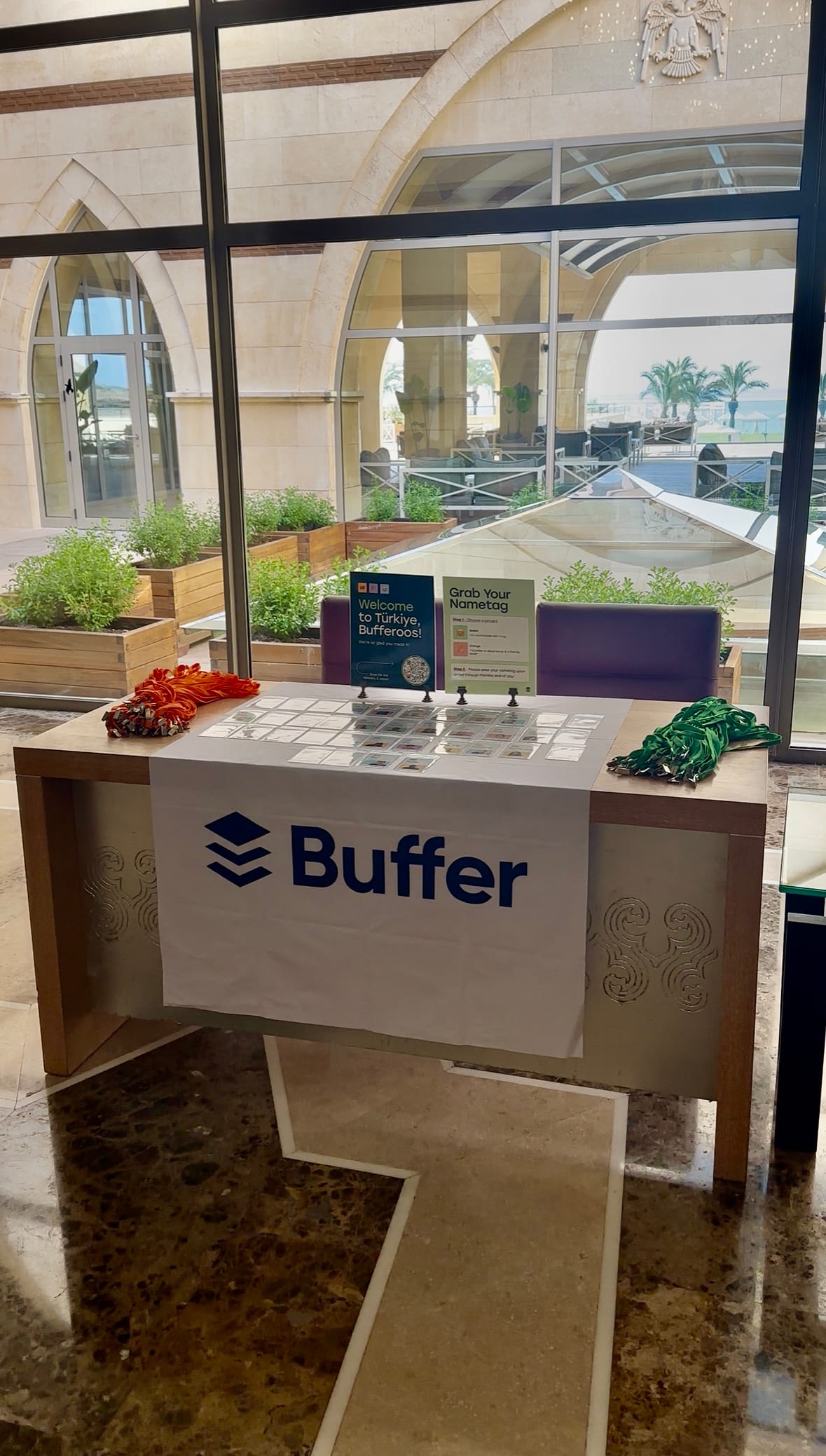
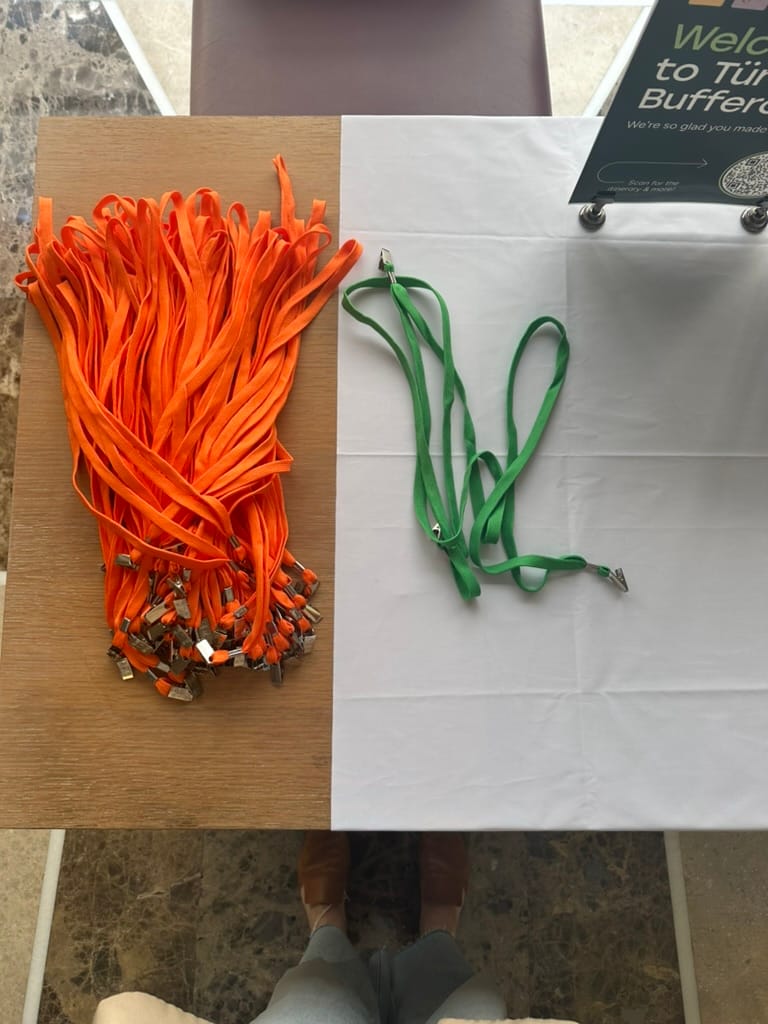
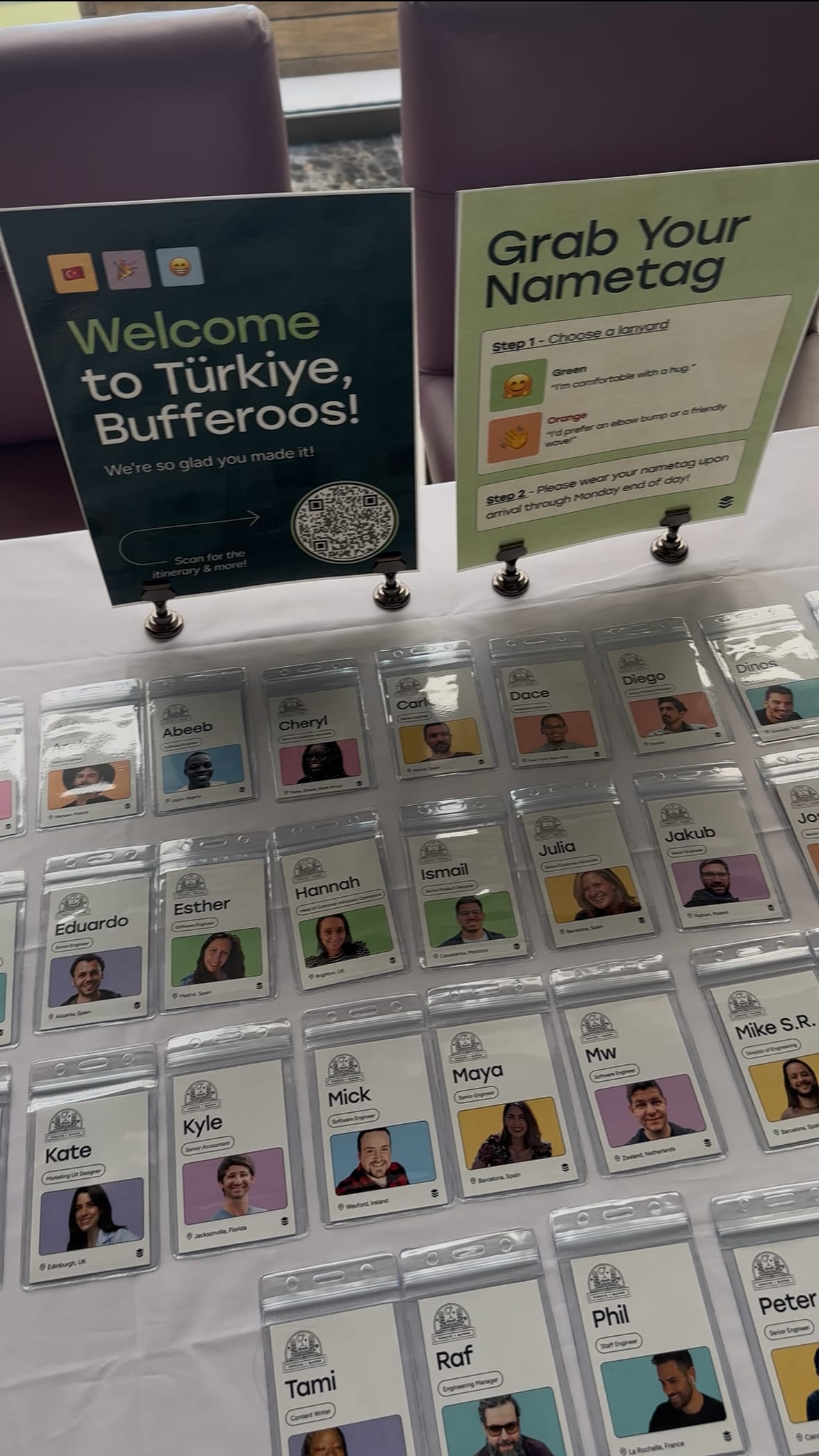
- Karaoke: The unofficial, yet very real, crown jewel of every Buffer Retreat. If the venue can swing it (or let us set it up), we're absolutely bringing the mic. There's something about belting out your favorite throwback that brings a team closer like nothing else. It's goofy, it's joyful, and it's peak Retreat bonding.
- Gratitude station: Living our value of “Show Gratitude,” we always carve out space for a little love note magic. We set up a gratitude station with blank thank-you cards so teammates can jot down notes of appreciation and hand them out before the week ends. Whether it's for a new friend, a behind-the-scenes hero, or someone who made you laugh so hard you cried, or showed up for you, there's something extra special about leaving Retreat with a pocketful of gratitude.
4. Customize swag: Our favorite items and what we’ve learned
Real talk: everyone loves swag. Like, really loves it. It's a Retreat highlight, and often the items are cherished for many years. We've learned (sometimes the hard way) that it's worth investing time and care into getting it right!
Start your search early
If you don't already have a swag vendor you love, start your vendor search early. You'll want someone who:
- Offers items your team will actually use
- Can ship internationally (as a global team, we prefer to have everything delivered to the resort).
- Is a true partner, not just a click-to-order site
We're still searching for our ideal swag-vendor match, but we're getting closer each year!
What we look for in a swag vendor
- Quality over quantity: We'd rather hand out a few awesome items than a bunch of “meh” ones. (That $5 water bottle? Not worth it.)
- Name-brand drinkware: Yeti, Stanley, Nalgene, etc. Always a hit.
- Customer service: We want a real human who'll walk with us from the first order to the final delivery. No bots, please.
- Shipping + customs expertise: Seriously, this matters.
- Ask how they calculate customs fees, and make sure all fees are included in their shipping quote.
- Find out how they support you if your items get stuck at customs.
- If the vendor can't tell you exactly what to expect in customs fees, be skeptical. Budget for thousands, not “surprises.”
- Can you tell that international shipping has been a challenge for us? Ask your swag vendor all the questions! A future idea we have is sending swag to a few US-based teammates to bring in checked luggage. Fewer customs headaches, fewer what-ifs, we'll let you know!
Some of our Retreat swag favorites
- The beloved tee. We're loyal to the Next Level Tri-Blend. We love the tee so much, we aim for one classic Buffer tee + one Retreat-specific design.
- Journal and pen for note-taking and doodling during sessions.
- Stickers! Lots of them. Inside jokes encouraged. Sticker Mule has been the best for us — great quality, fast shipping, and affordable.
- Something local or culturally special. Turkish towels were a huge hit in Türkiye!
- Tote or bag to carry it all, and it works perfectly for handing swag out.
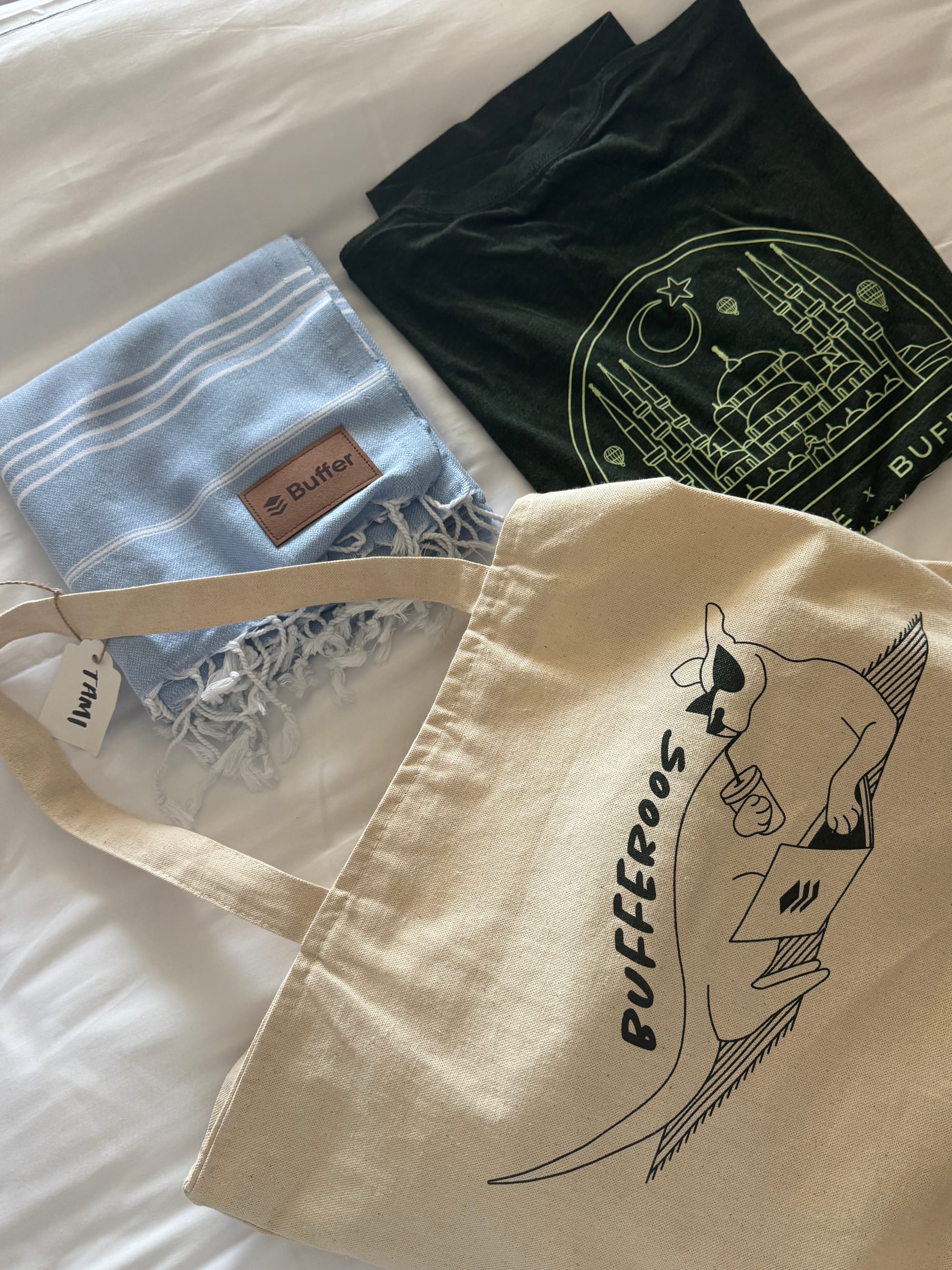
5. Plan a site visit: Why seeing the property in advance matters
If it's within budget (and we strongly recommend budgeting it in), do yourself (and your future self) a favor and go see the property in person.
We know it's not always possible, but if you didn't get a chance to visit before signing the contract, then a pre-Retreat site visit becomes a near non-negotiable. It's the fastest way to iron out details, avoid surprises, and feel confident that your beautiful plan will actually work in real life.
We've found that the sweet spot for a site visit is about 75 to 90 days before the Retreat. Much earlier than that, say, six months out, and the hotel likely isn't ready to dig into the nitty-gritty. Any later, and you might be scrambling to make changes in time.
This visit isn't just a quick tour, it's your chance to walk through the entire week on-site. Ask to meet with your main hotel contact, plus the food and beverage team, the A/V crew, and anyone else who plays a role in bringing your Retreat to life. Getting everyone in the same room helps eliminate those “I’ll have to check on that” moments and gives you clear answers while you're there.
6. Arrange transportation: Coordinate flights, arrivals, and ground logistics
Between flights, airport pickups, and jet-lagged teammates arriving from all corners of the globe, transportation is one of the most important (and underestimated!) parts of Retreat planning. Here are all of the transportation aspects we consider:
Flights
Once you've finalized the destination, we'd recommend checking in with your Finance team before launching flight bookings to the team. You'll want to align on budgets, the expense process, and timing, especially if flight costs will hit in the same billing cycle. At Buffer, most of our team prefers to book their own flights (seasoned travelers over here!), and we've found it to be more efficient than working through a booking service.
We typically offer a budget cap based on researched averages from major departure cities, padded a bit to cover seat selection and taxes. We cover economy fares that allow seat selection for long-haul flights and haven't required cancellation coverage in the past, though it's worth evaluating the cost impact and including if your budget allows! Giving teammates a clear booking timeline helps get things rolling, even if not everyone books right away. Just don't forget to clearly outline how to expense flights or use the company card, it's a small detail that saves a lot of back-and-forth later.
Ground transportation
Ground transportation is just as important, especially after 24+ hours of travel, depending on where the teammate is coming from. We aim for a simple, supportive experience where teammates can walk off the plane, spot the Buffer sign, and hop into a clean, safe ride. If you're working with a planning partner, lean on them to source vendors (bonus points if they've worked with them before). For us, clear communication in English, professional drivers, clean vehicles, and reliable arrival tracking are key. And yes, printed signs with our logo are a must, no scribbled Sharpie chaos, please.
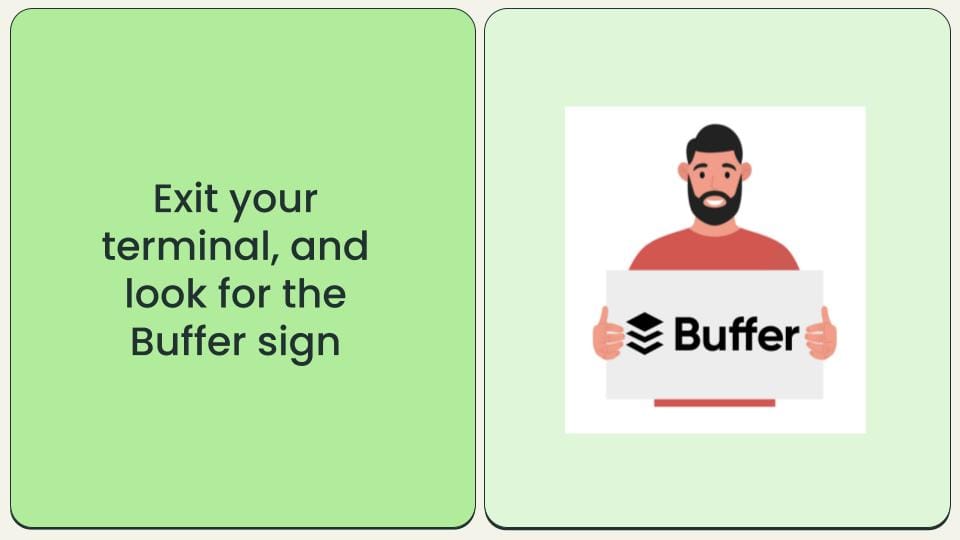
Keeping it all in one place
To keep everything organized, we use one shared transparent spreadsheet for transportation (one source of truth) that tracks it all: flight budgets, flight numbers and arrival/departure times, and ground transportation plans. This is also fun because teammates can see who might be traveling with them and who they should be on the lookout for!
7. Share a retreat resource: Centralize all the details for your team
Your team is about to travel across the world, some for the first time, some with multiple layovers, and everyone has different questions. That's why a centralized Retreat resource is so essential. This is the go-to hub for everything teammates need to know, and it helps ease nerves, build excitement, and reduce repeat questions (you'll still get some, but fewer!).
In our post-retreat feedback survey, one Bufferoo shared, “I felt fully informed and the plethora of beautifully-organized content in the Notion page made me feel so comforted!”
Start building your Retreat resource early, even if a lot of the details won't come together until the final month. We recommend getting the basics in place upfront and aiming to finalize it about two weeks before Retreat. That gives teammates time to read through everything as they start preparing for travel.
Within our Retreat resource (which we create and share in Notion), we include the following information:
- Hotel details
- Travel and transportation
- Details to have on hand for crossing the border (and any documentation needed)
- Full agenda and schedule
- Food and dining info
- What to pack and wear
- Expenses and reimbursements
- How communication and photos will work
- Health policies
- Ideas for free time activities
- Alcohol guidance (for All-Inclusive properties)
- The purpose behind Retreats
- Cultural expectations
- Safety tips
- FAQs
- How to participate from home, for teammates who aren’t joining in person
We know, it's a lot! We've found every section helps the team feel more prepared and having a place to point the team to for questions is key.
8. Programming for the week: Plan sessions with leadership and teams
Retreat programming doesn't just magically fall into place (if only!). It takes time, coordination, and a little bit of strategy, especially when you're hoping to loop in your leadership team.
While kicking things off three months out might sound early, we've found that early is actually the sweet spot. The more lead time, the smoother everything comes together and programming a big piece of the Retreat puzzle.
At Buffer, we're still fine-tuning our approach, but here's what tends to work: our exec team starts by aligning on the big picture, things like Retreat themes, company-wide sessions, and the kind of energy or outcomes we're hoping to create.
From there, we build out time for team-specific, department-level, and cross-functional sessions, using those high-level goals as our guide.
One tip: Try to shape the overall structure before asking leaders to plan their sessions. Otherwise, you can run into that classic “what comes first?" dilemma: leaders don't know when to schedule, and you don't know what to hold space for.
It also helps to loop team leads into the broader agenda early and ask them to start sketching out their session ideas once the framework is in place. Give folks plenty of time to prep, whether that's planning a brainstorming session, or dreaming up a team-bonding adventure. And don't be afraid to check in along the way. A gentle nudge can go a long way when everyone's juggling All The Things.
9. Team communication: Keep everyone informed at every step
When it comes to Retreat, your team wants to know everything, and honestly, the more you share, the better the experience for everyone. At Buffer, our value of transparency shows up big during Retreat planning. We've found that regular, open communication helps teammates feel more included, more prepared, and way more excited.
Start by sharing dates as soon as they're narrowed down. Even if they're tentative, early notice increases the chance that more teammates can attend.
From there, we keep everything centralized in transparent Slack channels:
- a planning channel, for the core planning team to coordinate for months in advance and through the event itself.
- a dedicated support channel, for any and all questions that teammates have as they plan, book flights, pack, travel, and submit expenses.
- a photo channel to collect all of the special memories and moments in real time.
- a chatter channel for anything and everything (cue spontaneous pool meetups!)
These channels start buzzing early (like when flights open up) and carry through the entire week on-site.
We also launch our Retreat resource and agenda well in advance, even if it's still a work in progress. Let the team know that changes will happen, but having a shared doc early on helps everyone follow along and get in the Retreat mindset.
Finally, we love carving out time during monthly All Hands to walk through key Retreat details and host a live Q&A. It gives teammates space to ask questions, share ideas, or just get hyped.
10. On-site coordination: final prep for a smooth Retreat week
Once the planning is done and your team is en route, it's time to switch into full-on on-site mode. These final details are essential for making everything run smoothly and helping your team feel cared for from the moment they arrive.
Our People team likes to arrive at the property two days ahead of the majority of the team, or one day ahead of those arriving early (we’ll offer this for those traveling over a day or for folks who can’t find flights in time for our welcome dinner). Use this time to do a full walkthrough with hotel staff and stakeholders, including your primary contact, the food and beverage team, and anyone managing AV or meeting spaces.
Review your meeting and event spaces – now is the time for final adjustments! We also use this time to set up our main session area with gratitude and Retreats stations, a first-aid station, journals/pens, pack swag bags, and test tech. Setting up a welcome table with nametags and welcome signage makes a huge difference in creating a welcoming first impression.
Once teammates start arriving, your phone becomes your lifeline. Keep it charged and be ready to field transportation updates, coordinate arrivals, or handle hotel questions (we recommend WhatsApp groups for vendor communication). You'll also want to arrive early for any team events or sessions to do one last check of the space.
And while you're moving behind the scenes to make it all happen, don't forget to give yourself some grace. If you can't be fully present at sessions and events, that's okay; it's all part of the process. Supporting the team is your role during Retreat, and it's a big part of what makes the whole thing successful.
Lastly, remember: you're a part of this experience, too. So take a deep breath, say yes to spontaneous meet-ups when you can, and enjoy the magic you helped create. ✨
Try Buffer for free
140,000+ small businesses like yours use Buffer to build their brand on social media every month
Get started nowRelated Articles
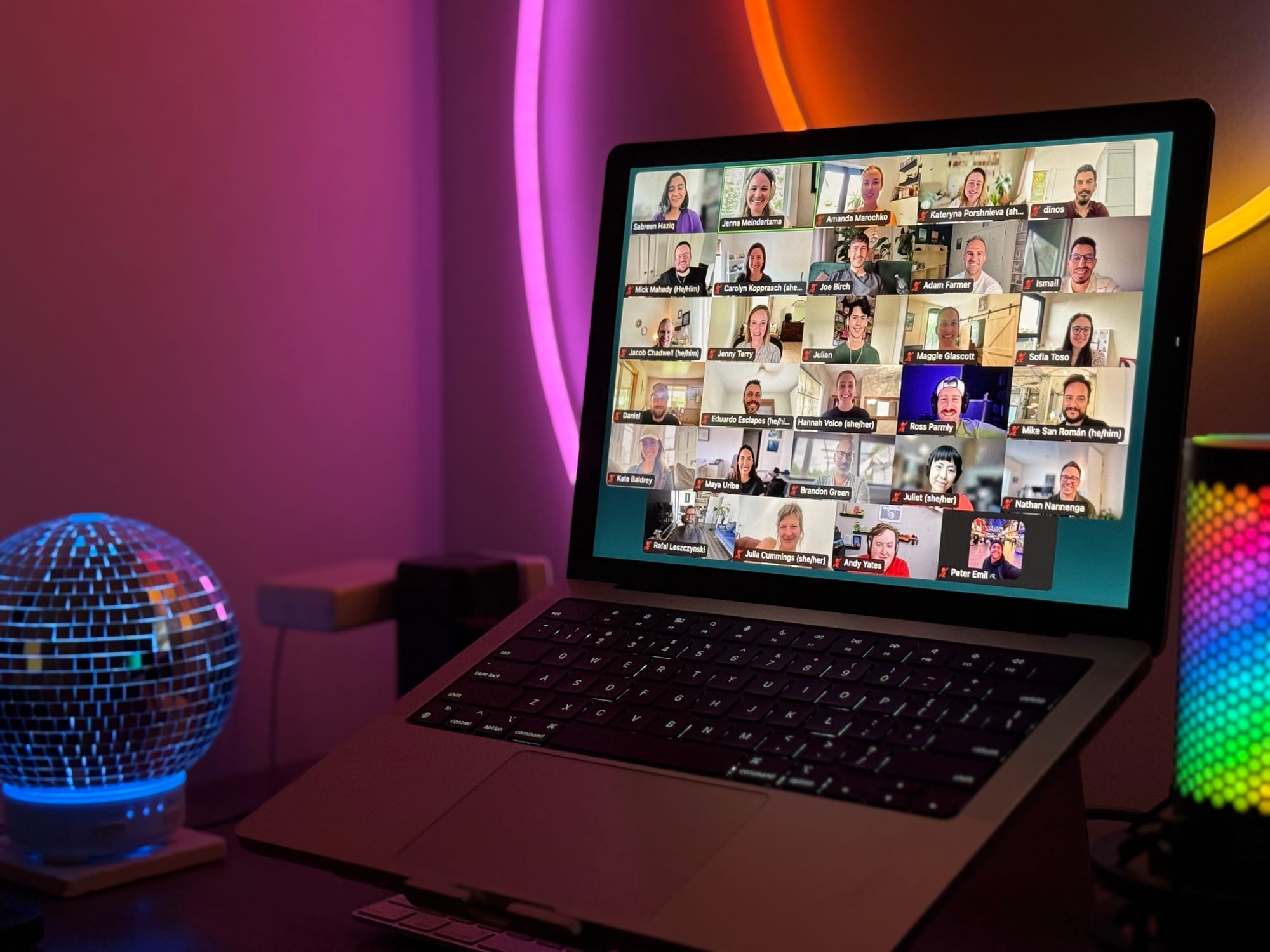
We’re intentionally investing in building a team of Buffer creators as a company-wide initiative. Here's exactly how (and why we're doing it).

In this article, Suzanne, Buffer's Operations Manager, goes in-depth on how we encourage self-improvement at Buffer.

A big-picture view of why we’re rebuilding the API at Buffer, who it’s for, and where we’re headed next.